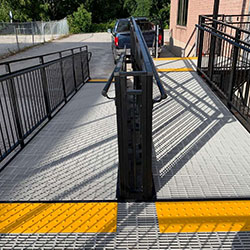









Tactile Walking Surface Indicators (TWSIs), also referred to as detectable warning surfaces or tactile attention indicators, serve as standardized walking pathways that convey vital information to individuals with visual impairments through the use of distinctive textures and occasionally auditory cues.
These surfaces are typically constructed using inserts made of various materials such as metal, rubber, stone, or plastic, or they can be directly integrated into concrete ground surfaces. TWSIs are designed to offer a discernible texture underfoot, detectable by a long cane. Furthermore, their edges are intentionally angled or bevelled to minimize the risk of tripping.
• Attention TWSIs, also known as warning TWSIs, draw awareness to significant hazards such as the commencement of a staircase or the perimeter of a platform.
• Guidance TWSIs, alternatively called wayfinding TWSIs, provide directional information within open spaces, aiding individuals in navigating along designated paths.
TWSIs should exhibit a noticeable contrast in color compared to the surrounding walking surface. For attention TWSIs, the recommended color is safety yellow (Munsell Colour System: hue 5.0, chroma yellow 8.0/12). Another effective approach involves using a light hue on a dark ground surface or a dark hue on a light ground surface. To clearly distinguish warning information from guidance information, it is advised not to employ safety yellow for guidance TWSIs.
When TWSIs are installed as pre-fabricated panels or affixed onto existing ground or floor surfaces, the panels themselves should feature bevelled edges. The base surface of the TWSI panels should not exceed three millimeters above the existing surface. While surface-mounted installations are less than ideal, they may be considered only when alternatives such as cast-in-place or recessed installations are not feasible.
TWSIs should always be attached firmly to prevent edges from lifting.
Attention Tactile Warning and Safety Indicators (TWSIs) play a crucial role in conveying vital safety information to individuals present in potentially hazardous areas, especially those with visual impairments. Their primary purpose is to serve as markers for identifying potential dangers. It is imperative to maintain uniform safety messaging to ensure that individuals with visual impairments can readily identify precarious situations regardless of their location, be it a town or province.
TWSIs should comprise circular or flat-topped truncated domes or cones that are securely installed on pedestrian surfaces.
Attention TWSIs should have the following specifications:
The spacing between adjacent flat-topped domes or cones should be adjusted depending on their size. The larger the individual domes/cones, the more distant the space between them.
Attention TWSIs should be used at the following locations:
Attention TWSIs used on platforms, ferry docks and other drop-offs should be:
At stairs, attention TWSIs should commence one tread depth back from the leading edge of the nosing at the top step and extend across the width of the stairs. The attention TWSI alerts a person with vision loss that there is a set of stairs ahead and to seek the support of a handrail for safe navigation. The depth of the TWSIs used at the top of stairs should be 600 – 650 mm.
At railway crossings, attention TWSIs should be located so that the edges of TWSIs are 1,800 – 4,600 mm from the centre line of the nearest rail. Attention TWSIs should be installed in addition to any mechanical barriers that are activated with the arrival of trains.
Attention TWSIs should be provided across the entire width of a curb ramp or depressed curb (exclusive of flares). They should be set back 150 – 200 mm from the curb’s edge and extend 600 – 650 mm in the direction of travel.
Guidance TWSIs should consist of a pattern of parallel, flat-topped, elongated bars that extend in the direction of travel.
Guidance TWSIs are appropriate at the following locations:
Follow these specifications for guidance TWSIs:
An alternate type of guidance TWSI should be used on road surfaces to assist persons with vision loss to navigate complex road crossings including, but not limited to crossing at:
TWSIs used on road surfaces are clearly different and distinguishable from the guidance surfaces used in pedestrian areas. Guidance TWSIs on road surfaces at pedestrian crossings should:
